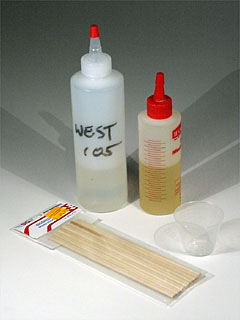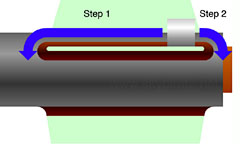 Essential ingredients and tools, epoxy, mixing sticks and disposable
measuring cups.
Essential ingredients and tools, epoxy, mixing sticks and disposable
measuring cups. |
|
 |
The Proof is in the
Pudding
The primary concept is to create a mixture of epoxy that is light
enough and thick enough to retain it's shape and give you plenty
of time to work with it.
For epoxy, I mix West Systems 206 and 105. I don't use the West
System pumps, which make about five times the amount of epoxy I
typically need. Instead, I transfer resin and hardener to squirt
bottles. Usually, I mix up 4 drams of epoxy.
While the mixture is pure epoxy, I pour a few drops of it in the
fillet areas. Then I use a paper towel to work it into the surfaces.
My mixture for Epoxy Pudding is about 30% epoxy, 30% microfibers
(for strength) and 40% phenolic Micro-balloons (for lightness) by
volume. I add the microfibers first because they mix more easily
if added first. Next, I add the phenolic micro-balloons, a little
bit at a time until the mix has the consistency of a thick milk
shake or pudding. The Prather phenolic micro-balloons (PRA700000)
give the epoxy a deep reddish brown color. Lately, I've experimented
with colloidal silica. It is extremely light, but somewhat hard
to sand.
The colored epoxy has a couple of nice side benefits. First, it
is much more visible than clear epoxy, so you can see everywhere
the epoxy is while applying it.
Second, it's much easier to see while sanding. |
 |
|
Pour the thickened epoxy mixture in
the fillet areas and shape the fillets by running the PVC pipe the
length of the fins. Run the PVC pipe around the leading and trailing
edges.
I start from the back as shown and work forward in about 10 seconds.
Then I place the PVC at the back again and complete the trailing
edge. I go extra slowly on the leading and trailing edges to avoid
pulling the epoxy upwards while taking the "corners".
Clean the PVC pipe frequently during the session with as paper
towel soaked with alcohol. |


